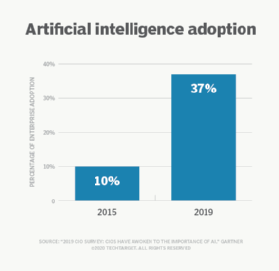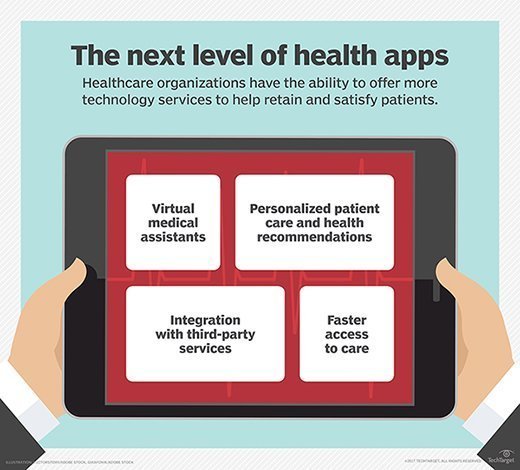
phonlamaiphoto - stock.adobe.com
How AI adoption by industry is being impacted by COVID-19
While COVID-19 has impacted budgets and businesses plans, some industries are seeing improved processes and consumer relationships due to new investments in AI and automation.
In the current global pandemic, interest and adoption of AI, machine learning and related cognitive technologies have been gaining traction in nearly every industry.
The coronavirus pandemic has brought disruptive enterprise change with reduced hours, remote work, increased online conferencing and collaboration systems, and dramatic changes in priorities. Now, perhaps more than ever, companies are looking for ways to successfully navigate a rapidly changing world by utilizing AI technologies.
Healthcare and financial sectors see an AI boom
In the wake of the COVID-19 outbreak, AI played a pivotal role in keeping organizations moving safely, accurately and with minimal delays. In particular, the healthcare sector was quick to adopt automation and AI to address the impacts of dramatic increases in telemedicine and rapid testing, alongside AI aiding in new treatments and healthcare operations.
AI technology has been instrumental in helping to detect and diagnose the virus, predicting the evolution and tracking the spread of infections. Additionally, AI applications assist with fast-tracking research on drug discovery, slowing the spread of infection through contact tracing and assisting in recovery. Automation and AI technology has also eased the sector's administrative burden by automating various processes. Data processing algorithms can pull data from internal systems and automatically generate reports while also generating necessary audit trails, prioritizing tasks and using natural language processing to create automatic clinical notes. This gives doctors and caregivers the ability to focus on patients while keeping necessary processes and procedures running smoothly.

Due to increased remote work and decreased in-person interactions, online retailers, food delivery companies and e-commerce companies saw dramatic increases in demand nearly overnight. As a result, these companies needed to quickly change their workforces to deal with the demand -- with many organizations shooting for a digital workforce.
For human workers, AI helps process applications, scan for qualifications and eligibility to be hired, and other important initial hiring checks. Digital workers in retail industries can streamline online ordering, add chatbots and improve delivery systems.
The financial services sector has also seen a dramatic rise in automation and AI tools to quickly help service its customers during the pandemic. Banks are utilizing AI to help find solutions for customers to safely upload important documents, then identify and categorize these documents to keep the process moving along without creating huge bottlenecks. Additionally, with the passage of the Coronavirus Aid, Relief, and Economic Security Act (CARES Act) banks were bombarded with loan requests for the Paycheck Protection Plan (PPP). Banks that did not quickly adopt automation and AI technologies felt the strain of processing these loans before the set deadline. Remote banking also saw dramatic surges in use with reduced banking hours and the desire for work-from-home individuals to limit their in-person banking experiences.
Country-level AI strategies
The global pandemic has affected almost every country around the globe. Many countries are changing their strategy for AI adoption. Artificial intelligence is becoming a powerful tool for tracking and treating COVID-19 in the U.S. and abroad. In particular, the importance of contact tracing, image recognition systems that can monitor temperatures, and increased use of predictive analytics has made AI front and central in the battle to control COVID-19.
The United States continues to see AI as a powerful tool in helping to identify and treat patients. Movement to accelerate the country's national AI strategy has only increased since the pandemic started. Efforts in U.S. Congress, including the AI in Government Act of 2020, indicate a continued push for strategic development of AI at the highest levels.
Likewise, the current global pandemic has given China a chance to amplify its efforts to apply AI across public and private spheres. Chinese companies are developing and retooling AI systems for virus control and prevention. China has expanded its use of facial recognition and image-based surveillance systems for contact tracing.
Across the world, AI efforts continue to accelerate in the face of COVID-19. The European Commission plans to invest in the use of AI to speed up the diagnosis of COVID-19 and improve the future treatment of patients. Other nations in Africa, South America, Asia, Australia and elsewhere have also realized the importance of advanced forms of analytics, recognition systems and conversational apps to accentuate effort in this new remote environment.

AI, COVID and the year ahead
It's been over nine months since COVID-19-related lockdowns, border closures and travel restrictions were first issued. The recent pandemic has challenged many industries, governmental agencies and organizations of all types. The pandemic has quickly forced organizations to adapt and change so that remote employees can remain productive, essential employees can safely perform their job and operations can maintain continuity.
Many legacy systems and processes that organizations put in place have been stressed to the point where they need to be adapted to keep up with changes to customer volume and behavior and the increased and sudden stresses put on existing systems, people and processes. Without the increasing use of AI in many industries, companies are going to continue to be overwhelmed with demand, put a strain on existing resources, and fail to fully adapt and function with a remote workforce. Contrary to the idea that the pandemic shrank budgets and investments, COVID-19 nudged investment in AI across sectors and nations -- a trend that will continue for years to come.






